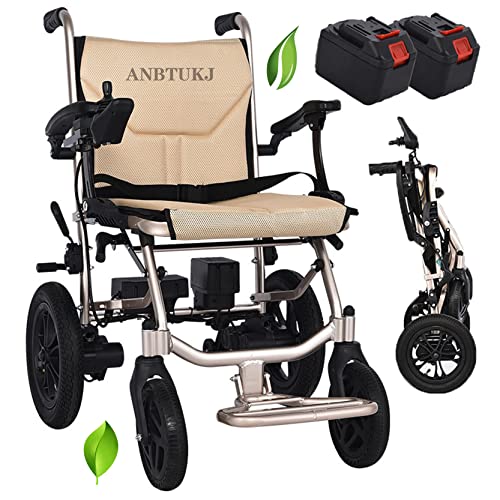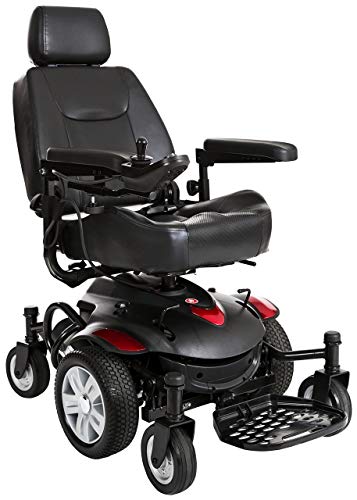20 Things You Should Be Educated About Electric Wheelchair With Joysti…
페이지 정보
작성자 Milagro 작성일 24-09-24 12:01 조회 10 댓글 0본문
 electric powered wheelchairs Wheelchairs For Sale - Anorectal-Malformation.Org - Wheelchair With Joystick
electric powered wheelchairs Wheelchairs For Sale - Anorectal-Malformation.Org - Wheelchair With JoystickJoysticks on power wheelchairs can significantly increase accessibility and independence. Standardized joysticks may not accommodate the unique features of hand impairment.
This study evaluated the effectiveness and satisfaction of customized power wheelchair Joysticks made with 3D printing. The test was conducted using modified power-mobility assessment (PIDA), National Aeronautics and Space Administration Task Load Index, and Psychosocial Impact of Assistive Devices Scale.
Control
The control system of a power chair includes two key components: the joystick and the electronic. Standard joysticks often mount to either the left or right sides of the chair, whereas more complex rehab chairs may include swing-away mounts that allow the joystick to be moved into the middle of the seat.
The way that a joystick is installed and used will play a crucial role in determining whether it can be effective for a specific client. If a client has a high number of tremors, it is essential to design the joystick such that the movements do not cause the chair to move accidentally. Standard EPW joysticks use proportional input devices that react to the deflection amount of the gimbal to control the chair's motion (similar to the video game controller or automobile accelerator pedal).
However, there are now a number of different alternative control options available for power wheelchairs that require only a little force to activate. Switch controls, sip-and puff controls as well as head arrays and chin controls are all accessible. Some of these controls require an additional interface to connect to the wheelchair. However, most of them work with new joysticks that incorporate Bluetooth into the handles.
Some of the standard wheelchair joysticks come with a screen to display the status of the system and provide feedback to the user, which is particularly beneficial for people with visual or cognitive impairments. Certain advanced joysticks are able to control a wide range of accessories that include televisions, environmental controls and tablet.
Whatever the technology, a joystick is only as effective if it is comfortable for the user to operate. It is therefore crucial to consider the size of the buttons and their placement on the joystick to make them easy to access. It is also essential to take into consideration the sensitivity of the joystick which can be adjusted to a range of levels according to the needs of each client.
Comfort
A joystick-controlled wheelchair has many advantages that a manual chair does not offer. They limit fatigue caused by operational factors and allow for longer travel distances over manual wheelchairs. They can also be used in areas that have less space or more challenging terrain, such as outdoor slopes and uneven surfaces. With this added independence users will experience an ease of movement that gives new life to their lives and reminds users of the feeling to be able to move around independently.
A variety of power wheelchairs are available with an array of options. The number of bells and whistles the particular model comes with will depend on what the user wants and needs. The most commonly used features are:
Controls on an electric power chair wheelchair with joystick can be customized to meet the needs of each individual. This includes the kind of knob or handle, or ball, and the way it is mounted. Some joysticks are positioned on the end of the dominant armrest, while others are located in the front or back of the seat for easy access by a person who is. Certain joysticks can be placed on the side for those who have limited shoulder range or muscle weakness.
Other features are more personal to you, such as the size and design of the joystick display screen. Some models are backlit or have colors that make it easier for those who have low vision to read. Some models have additional modes that provide audio or visual navigation signals. Other models may include odometers, clocks, and indicators for battery charge.
Another crucial aspect of the joystick is how it can be carer controlled electric wheelchair in an area with a tight turning radius. The best-performing models will have a tight turning radius that allows for easier navigation of obstacles in small spaces, such as hallways. This tight turning radius allows for easier navigation in public places and in stores. This tight turning circle is especially beneficial for those with mobility issues, such as cerebral palsy, or other mobility issues such as multiple sclerosis ALS and Huntington's disease, brainstem or spinal cord injury stroke.
Safety
Power wheelchairs have been designed with safety as a top priority. They are equipped with reliable brake systems that can reduce speed rapidly when the user presses the joystick control lever. They also have anti-tip wheels in the rear to prevent the chair from tipping forward.
The most popular type of joystick is one that is proportional. It is similar to video game controllers as well as accelerator pedals for cars, in that it accelerates the wheelchair the further it is from the center. These types of joysticks require intact proprioception and finger dexterity in order to operate effectively. The standard joysticks are positioned on the armrest. However there are several special controls that place the controls on the side or middle of the seat.
Even with specialized rigging some people might not be able to turn a handle. This could be the case for those with spasticity, and this can cause muscles to become stiff or deteriorate (atrophy). In these instances it is possible to use a head-control device that converts the movements of the consumer's body into the required commands for the wheelchair.
Another aspect to consider is the size and placement of buttons on the joystick. If the buttons are located too far forward or difficult to reach, it could affect the user's position and result in strain on their hands. If the joystick is placed too far back, it could be difficult to move the chair or turn the wheels.
Lastly, an electric automatic wheelchair wheelchair is best operated with a seatbelt that is fastened. The most powerful wheelchairs can travel at speeds of up to 8 miles per hour, and an unfastened seatbelt can lead to serious injuries or death. Batteries should be charged regularly and at least every night. This will ensure they have a longer lifespan and maintain their efficiency. It's also recommended to perform regular maintenance on your chair to ensure that all components are functioning properly.
Accessories
The joystick is a major element of any power wheelchair, and there are numerous accessories that can be added to improve its functionality. These can range from simple switches up to more complex interfaces that connect to communication devices, and even external environmental control units. Higher-end power wheelchairs will often have a variety of controller components that can satisfy the requirements of different users. For example, a non-expandable controller will generally only accept a proportional joystick as an input device. However, an expandable controller can allow sip and puff controls, special switches, and head array systems. Some advanced controllers can also use up to two power seating actuators that can be used to adjust the position and tilt of the seat.
The most common type of joystick used in clinics is a proportional joystick also known as a movement-sensing joystick. This type of joystick similar to accelerator pedals in cars and video game controllers responds to the force applied on the stick by increasing its output (i.e. The speed of the wheelchair increases as the stick is moved away from the center. This requires a lot of dexterity and a healthy sense of proprioception for effective use.
The technology that is used today is able to compensate for a small variations in amplitude when EPW driving. However, it is unable to detect and adjust for many more serious unintentional movements, such as those caused larger amplitude tremors, or involuntary movements that aren't associated with conscious intention like athetosis.
Most wheelchairs have a range of different parameters that can be programmed or customized usually with the assistance of a medical professional. These parameters include changing the torque produced by the motor, and adjusting the speed of the chair. They can also be used to determine the dead zone, which is the distance in which the EPW isn't able to produce output. Some controllers also allow the clinician to save backup programs. This is beneficial in an emergency situation or if a patient's symptoms alter.

- 이전글 Transform Your Parking Lot Into a Profit Center With Advanced Software
- 다음글 Surveys4checks Review - Take Control Of Your Earnings
댓글목록 0
등록된 댓글이 없습니다.